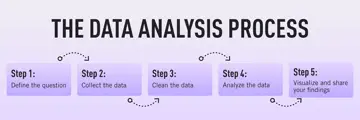Data analysis is a thorough process of examining, purifying, converting, and modeling data to find relevant information, make inferences, and aid in decision-making. It is a complex process that involves a variety of approaches and procedures to analyze data in diverse formats, both structured and unstructured, from a variety of sources.
Data analysis is a tool that helps businesses anticipate trends, make well-informed decisions, and run more smoothly. It is the cornerstone of corporate, governmental, and other strategic planning.
Businesses are becoming more aware of the advantages of using data. By way of illustration, a healthcare system using data analysis can forecast future medical needs, a bank can tailor customer interactions, and an entertainment firm can use it to develop the next big streaming hit.
Data analysts and scientists were ranked as the top rising careers in the World Economic Forum Future of Jobs Report 2020, closely followed by experts in AI, machine learning, and big data.

In a modern organization, data analysts are essential because they assist in evaluating the work and clientele the firm has, assess how these aspects have impacted earnings, and provide leadership with guidance on how to operate and expand the company.
A data analyst can execute statistical studies on data, acquire information using surveys, software, and other tools, and analyze the results to guide important business decisions. A data analyst might, for instance, look over the demographics of website users who clicked on a certain advertisement campaign. The effectiveness of the campaign, whether it is reaching its target demographic, and whether money should be spent on this kind of advertising again might all be determined using the data.
Step 1: Setting Objectives and Crafting Questions
Beginning data analysis requires setting clear objectives and crafting targeted questions. This crucial phase guides the entire process, ensuring clarity on the issue, identifying required data, and defining evaluation metrics.
Step 2: Data Collection
The next step is gathering relevant data. This involves various methods such as surveys, interviews, observations, or extracting from existing databases. Data can be quantitative or qualitative, tailored to fit the problem and inquiries.
Step 3: Data Cleaning
Data cleaning is crucial for maintaining analysis integrity. This stage involves identifying and rectifying errors and inconsistencies, ensuring data quality and reliability for accurate insights.
Step 4: Data Analysis
After cleaning, data undergoes analysis using statistical or mathematical techniques. Tools like Python, Excel, SPSS, and SAS aid in uncovering patterns or trends.
Step 5: Data Visualization
Following analysis, data is interpreted and visually presented using charts or graphs for clarity and understanding

Effective data analysts besides strong statistical and quantitative abilities also have:
In addition, the required qualifications for recruiting for this position are also strictly specified as:
Here are some tips for anyone considering a job as a data analyst in the future:
As a student in data analysis, your main focus should be on grasping statistical concepts and becoming proficient in programming languages like Python and R. It's crucial to dive into real datasets to gain hands-on experience, paying special attention to tasks such as data visualization, cleaning, and considering ethical implications. Remember to stay curious and keep learning, collaborate with classmates, and work on improving your communication skills. These elements form the solid foundation for your ongoing growth in this field.